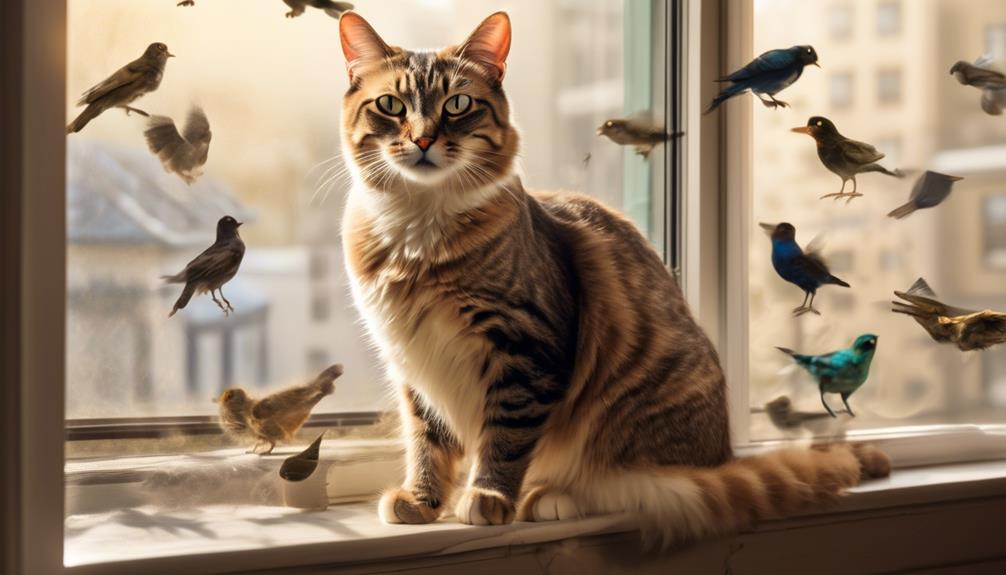Why Do Cats Chatter at Birds and What Does It Mean

Cats chatter at birds as a result of their innate hunting instincts and the excitement of potential prey.
It is a way for them to express their desire to pounce and catch the birds.
The Behavior of Chattering at Birds
The behavior of chattering at birds is a common and instinctual response exhibited by cats when they encounter a potential prey animal. Chattering is a series of quick, rhythmic jaw movements that give the impression that a cat’s teeth are clicking together. It’s often observed when a cat has sighted a bird or a rodent, expressing excitement or frustration at not being able to reach its prey. This behavior may serve as a hunting strategy, as it allows the cat to practice the precise jaw movements necessary for killing prey swiftly.
When a cat chatters, there are several signs to look out for. The cat will exhibit intense focus, with widened eyes and jaw movements. Additionally, they may emit high-pitched or soft gasping sounds. It’s important to note that chattering is a normal behavior and shouldn’t be reprimanded. Cats have a natural instinct to hunt, and chattering is one way for them to express their hunting instincts.
For indoor cats, providing stimulation and entertainment can help satisfy their hunting instincts. Interactive toys, puzzle feeders, and playtime can all contribute to a cat’s overall well-being. Understanding and embracing a cat’s natural behaviors, such as chattering, can promote a sense of freedom and fulfillment for both the cat and its owner.
Understanding Cat Chattering

After understanding the behavior of chattering at birds, it is important to delve into the underlying reasons and motivations behind this intriguing cat behavior. Cats chirp at birds because their hunting instincts kick in, and they are expressing excitement or frustration at not being able to reach their prey. Additionally, chattering may serve as a hunting strategy, with cats mimicking the cries of birds and rodents to get closer to their prey.
| Reasons for Cat Chattering | Motivations Behind Cat Chattering | Implications |
|---|---|---|
| 1. Hunting Instincts | Cats have an innate drive to hunt, and their chattering behavior is a manifestation of their natural instincts. By chirping at birds, cats are priming themselves for the chase, preparing to pounce, and honing their hunting skills. | Understanding the motivations behind cat chattering allows cat owners to appreciate and encourage this natural behavior, providing opportunities for their cats to engage in hunting-like activities. |
| 2. Expression of Frustration | When cats chatter at birds, they may be expressing frustration at not being able to reach their prey. This frustration stems from their strong desire to catch the bird and fulfill their predatory instincts. | Recognizing this frustration can help cat owners provide alternative outlets for their cats’ energy, such as interactive toys or puzzle feeders, to alleviate their frustration and prevent potential destructive behaviors. |
| 3. Mimicking Prey Sounds | Chattering may also involve cats mimicking the cries of birds and rodents. By imitating the sounds of their prey, cats can lure them closer, increasing their chances of a successful hunt. | Understanding this mimicry behavior can help cat owners appreciate the complexity of their cats’ hunting strategies and provide enriching environments that allow them to practice their vocalizations and hone their hunting skills. |
Reasons Behind Cat Chattering

Cat chattering is a behavior characterized by quick, rhythmic jaw movements often observed when cats have sighted a prey animal like a bird or a rodent. One reason behind cat chattering is hunting. The behavior may express a cat’s excitement or frustration at not being able to reach the prey, and it could also be a way for cats to communicate their desire for the prey.
Chattering and chirping may be a form of mimicry used as a hunting strategy, with cats imitating the calls of birds and rodents to get closer to their prey. This mimicry helps cats mimic the cries of their prey to get closer before pouncing, allowing them to kill their prey swiftly.
Additionally, chattering noises could be purely due to excitement. Cats feel delight and eagerness when they see birds nearby, and chattering may be a way for cats to express their excitement.
Decoding the Meaning of Chattering

Decoding the meaning of a cat’s chattering involves understanding its vocal hunting behavior, bird mimicry behavior, and the underlying emotions of frustration or excitement.
When cats chatter, they’re mimicking the sounds made by their prey, using it as a hunting strategy to get closer before pouncing. This behavior is an adaptive technique that’s linked to neurotransmitters and hormones, contributing to the cat’s overall hunting instinct.
Vocal Hunting Behavior
Vocal hunting behavior in cats can be decoded by understanding the meaning behind their chattering. When cats chatter at birds, it serves as a display of their predatory instincts and can be seen as a form of communication. Here are three key points to consider:
- Excitement and Frustration: Chattering is often accompanied by excitement or frustration when cats spot their prey, such as birds. It’s a way for them to express their eagerness to hunt and capture the elusive prey.
- Mimicking Prey: Cats may use chattering as a mimicry technique to get closer to their prey before pouncing. By imitating the sounds of small animals like birds, they may attempt to lure their prey into a false sense of security, making it easier to launch a surprise attack.
- Instinctual Behavior: Chattering is a natural behavior rooted in cats’ wild instincts. Even domesticated cats exhibit this behavior, indicating their innate hunting drive. By chattering, cats are likely preparing themselves mentally and physically for the act of capturing and killing their prey swiftly.
Understanding these aspects of vocal hunting behavior in cats can provide insight into their natural instincts and behaviors when it comes to hunting prey like birds.
Bird Mimicry Behavior
After exploring the vocal hunting behavior of cats, it’s now important to examine their bird mimicry behavior and decode the meaning behind their chattering.
Chattering in cats is a unique behavior characterized by quick, rhythmic jaw movements and teeth clicking together. When cats chatter at birds, it may serve as a form of mimicry behavior. By imitating the calls of birds and rodents, cats can potentially get closer to their prey without alerting them to their presence.
This mimicry strategy allows cats to increase their chances of successfully capturing their prey. The chattering noises could be a way for cats to communicate their excitement or frustration at not being able to reach the prey. Regardless of the exact reason, bird mimicry behavior and chattering are natural and instinctive behaviors for many feline species.
Frustration or Excitement
When cats chatter at birds, their behavior may be indicative of either frustration or excitement in their attempt to capture their elusive prey. Here are three important facts about this behavior:
- Chirping as a hunting strategy: Chattering and chirping may serve as a form of mimicry used by cats to get closer to their prey. By imitating the calls of birds and rodents, cats can deceive their prey and increase their chances of a successful hunt.
- Communicating desire for prey: Chattering is believed to be a way for cats to express their excitement and frustration at not being able to reach their prey. It may serve as a means of communication, signaling their desire to catch the elusive bird or rodent.
- Instinctive behavior: Chattering is a natural and instinctive behavior for many feline species. It’s thought to be related to the instinct of swiftly killing prey, as it helps cats mimic the cries of their prey and get closer before pouncing.
Cat Chattering and Communication

Cat chattering, characterized by quick, rhythmic jaw movements and low-amplitude jaw sounds, is a behavior observed in cats when they spot prey animals such as birds or rodents. This behavior is believed to be a manifestation of their natural hunting instincts. Cats may use chattering as a means of communication to express excitement or frustration at not being able to reach their prey. It is also thought to be a form of mimicry used as a hunting strategy.
The chattering behavior is believed to be an instinct related to killing prey swiftly. It is observed in cats of different sizes, suggesting that it is a universal behavior. By mimicking the sounds of their prey, cats can get closer before launching an attack. Chattering may also serve as a way for cats to simulate biting down on their prey, further enhancing their hunting instincts.
To better understand the communication aspect of chattering, let’s take a closer look at the behavior and what it may convey to other cats or potential prey:
| Communication | Meaning |
|---|---|
| Chattering | Expressing excitement or frustration at not being able to reach prey |
| Mimicry | A hunting strategy to get closer to prey before attacking |
| Biting simulation | Enhancing hunting instincts and preparing for an attack |
Is Chattering a Natural Instinct?

Chattering, characterized by quick, rhythmic jaw movements and low-amplitude jaw sounds, is a behavior observed in cats when they spot prey animals such as birds or rodents, suggesting that it’s a natural instinct. But is chattering truly an innate behavior? Let’s explore the evidence:
- Mimicry as a hunting strategy: One possible explanation for chattering is that cats imitate the calls of birds and rodents to get closer to their prey. By mimicking the sounds of potential victims, cats may be able to deceive and draw their prey closer, increasing their chances of a successful hunt.
- Swift and efficient killing: Chattering behavior is believed to be an instinct related to killing prey swiftly. The quick, rhythmic jaw movements and low-amplitude jaw sounds may serve as a way for cats to practice their hunting skills and prepare for a successful strike. The faster the prey is killed, the lower the chance of injury to the cat.
- Excitement and eagerness: Another theory suggests that chattering could be purely due to excitement. Cats feel delight and eagerness when they see birds nearby, and the chattering may be a way for them to release their pent-up energy and express their anticipation of capturing their prey.
How to React to Cat Chattering

When reacting to cat chattering, it’s important to understand cat vocalizations and their meanings. By familiarizing oneself with the different sounds and body language associated with chattering, owners can better identify whether it’s an expression of excitement or frustration.
Redirecting their attention to interactive play can help satisfy their hunting instincts while engaging in playtime that mimics natural hunting behaviors. This can provide mental and physical stimulation, enriching their environment and promoting a healthier, happier cat.
Understanding Cat Vocalizations
Understanding how to react to cat chattering involves recognizing the significance of this behavior and its connection to a cat’s natural hunting instincts. Cat vocalizations, including chattering, serve as a way for cats to communicate their emotions and desires. Here are three key points to consider when understanding cat vocalizations:
- Chattering at birds: When a cat chatters at birds, it may express excitement, frustration, or desire for the prey. This behavior is linked to their instinctual urge to hunt and capture prey.
- Mimicry as a hunting strategy: Chattering may also be a form of mimicry used as a hunting strategy. By imitating the calls of birds and rodents, cats can attract their prey closer, increasing their chances of a successful hunt.
- Normal behavior: It’s important to remember that chattering should be considered a normal behavior and not reprimanded. Providing stimulation and entertainment for indoor cats is crucial to satisfy their natural hunting instincts.
Redirecting Their Attention
To redirect a cat’s attention away from chattering, provide them with alternative sources of stimulation and engagement. Indoor cats, in particular, need plenty of mental and physical stimulation to satisfy their hunting instincts. One effective way to redirect their attention is by using puzzle toys that hide food or treats. These toys simulate the thrill of hunting and provide a rewarding challenge for your cat. Additionally, offering opportunities for climbing, scratching, and flexing their claws can help redirect their focus. This can be achieved through the use of cat trees, scratching posts, and interactive toys. By providing these alternative outlets for their natural instincts, you can help divert their attention from chattering at birds and promote a more fulfilling and enriched environment for your feline companion.
| Alternative Sources of Stimulation | Benefits |
|---|---|
| Puzzle toys | hides food or treats, simulates hunting |
| Climbing structures | encourages physical activity and mental engagement |
| Scratching posts | provides an outlet for natural scratching behavior |
Engaging in Interactive Play
Engaging in interactive play with your cat is a beneficial way to respond to their chattering behavior and satisfy their natural hunting instincts. When your cat chatters at birds, it’s expressing excitement and frustration at not being able to reach its prey.
Here are three ways to engage your cat in interactive play:
- Use toys that mimic prey: Provide your cat with toys that resemble birds or small animals. This will give them an outlet for their hunting instincts and allow them to engage in simulated prey capture.
- Provide mental and physical stimulation: Interactive play sessions with your cat won’t only satisfy their hunting instincts but also provide mental and physical exercise. Use toys that require them to chase, pounce, and capture, keeping them mentally and physically stimulated.
- Rotate toys regularly: Cats can quickly lose interest in toys if they’re always available. To keep them engaged, rotate the toys regularly, introducing new ones periodically. This will prevent boredom and maintain their excitement during playtime.
Frequently Asked Questions
Why Do Cats Make a Chattering Sound When They See a Bird?
Cats make a chattering sound when they see a bird due to their hunting instinct. It serves as a communication signal, expressing both excitement and frustration. This behavior is a way for cats to mimic their prey and intensify their desire to hunt.
What Are Cats Saying When They Talk to Birds?
When cats chatter at birds, they are engaging in a form of cat communication. It is a behavior driven by their feline instincts and their love for bird watching. This behavior allows them to express their excitement and desire for the prey.
What Does It Mean When a Cat Chatters at You?
When a cat chatters at you, it’s their way of expressing excitement or anticipation. It’s a reflection of their natural hunting instincts and the bond they have with their prey. Understanding feline communication is key to decoding cat chatter.
Why Do Cats Make Ekekek Sound?
Cats make the “ekekek” sound as part of their vocalizations. It is believed to be an expression of their predatory instincts and a way of communicating with humans.










